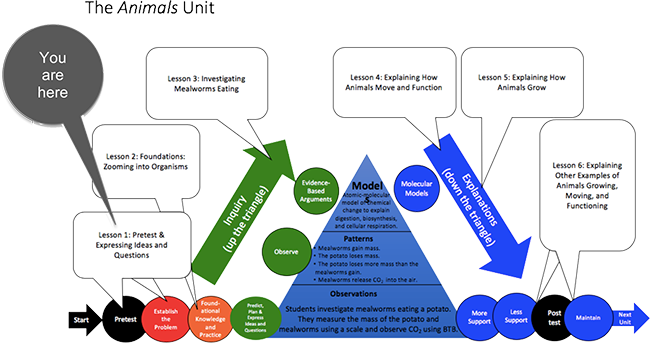Transformations in Matter and Energy Carbon TIME is an NSF-funded partnership led by Michigan State University
Lesson 1 - Pretest and Expressing Ideas
In this lesson, students take a pretest and share their initial ideas about animal growth, identifying what animals need to grow and gain mass.
Guiding Question
What happens to food that animals eat?
Activities in this Lesson
- Activity 1.1: Animals Unit Pretest (20 min)
- Activity 1.2: Expressing Ideas and Questions about How Animals Grow (40 min)
Unit Map

Target Performances
| Lesson 1 – Pretest and Expressing Ideas (students as questioners) | |
|---|---|
|
Activity 1.1: Animals Unit Pretest |
Students show their initial proficiencies for the overall unit goal: Questioning, investigating, and explaining how animals move and change matter and energy as they live, move, and grow. |
|
Activity 1.2: Expressing Ideas about How Animals Grow |
Students ask and record specific questions about changes in matter and energy in response to the unit driving question: What happens when ethanol burns? |
NGSS Performance Expectations
This lesson helps students start thinking about all of the unit NGSS Performance Expectations but does not feature a mastery of any of them.
Talk and Writing
At this stage in the unit, the students will be Expressing Ideas and Questions. The table below shows specific talk and writing goals for this phase of the unit.
|
Talk and Writing Goals for Expressing Ideas and Questions Phase |
Teacher Talk Strategies that Support this Goal |
Curriculum Components that Support this Goal |
|---|---|---|
|
Treat this as brainstorming and elicitation. |
Remember, there are no “right” answers at this point. We want to hear all ideas. |
Unit Pretest My Students’ Answers |
|
Listen for ideas about what is happening to matter and energy at different scales. |
Where did the energy come from? Where does the matter go next? Are you talking about matter or energy? What about the atomic-molecular scale? What about the cellular scale? |
Unit Pretest Expressing Ideas and Questions Process Tool |
|
Listen for a wide range of student ideas. Press for more complete ideas. |
Who can add to that? What do you mean by _____? Say more. I think you said _____. Is that right? |
|
|
Have students compare, contrast, and document their ideas. |
Who has a different idea? How are those ideas similar/different? Who can rephrase ________’s idea? Let’s record our ideas so we can come back to them and see how our ideas change. |
Sticky notes on the class poster Activity 1.2 Presentation |
|
Encourage students to provide evidence for their ideas. |
How do you know that? What have you seen in the world that makes you think that? |
Sticky notes on the class poster. |

 Download PDF of Lesson 1 Teacher's Guide
Download PDF of Lesson 1 Teacher's Guide